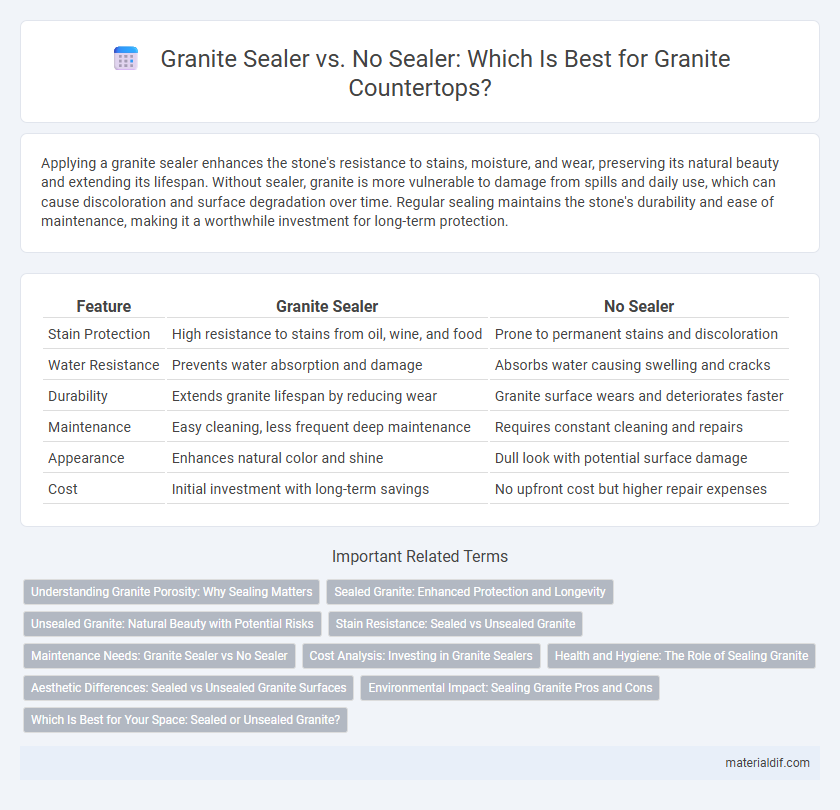Applying a granite sealer enhances the stone's resistance to stains, moisture, and wear, preserving its natural beauty and extending its lifespan. Without sealer, granite is more vulnerable to damage from spills and daily use, which can cause discoloration and surface degradation over time. Regular sealing maintains the stone's durability and ease of maintenance, making it a worthwhile investment for long-term protection.
Table of Comparison
| Feature | Granite Sealer | No Sealer |
|---|---|---|
| Stain Protection | High resistance to stains from oil, wine, and food | Prone to permanent stains and discoloration |
| Water Resistance | Prevents water absorption and damage | Absorbs water causing swelling and cracks |
| Durability | Extends granite lifespan by reducing wear | Granite surface wears and deteriorates faster |
| Maintenance | Easy cleaning, less frequent deep maintenance | Requires constant cleaning and repairs |
| Appearance | Enhances natural color and shine | Dull look with potential surface damage |
| Cost | Initial investment with long-term savings | No upfront cost but higher repair expenses |
Understanding Granite Porosity: Why Sealing Matters
Granite porosity determines its susceptibility to staining, as natural stone contains microscopic pores that can absorb liquids and oils. Sealing granite fills these pores, creating a protective barrier that prevents moisture penetration and reduces the risk of discoloration or damage. Without a sealer, granite surfaces remain vulnerable to spills and contaminants, which can compromise their durability and long-term appearance.
Sealed Granite: Enhanced Protection and Longevity
Sealed granite surfaces benefit from a protective layer that prevents staining, moisture infiltration, and damage from daily wear. This sealing process extends the longevity of granite countertops by maintaining their natural color and polished appearance. Without a sealer, granite is more susceptible to absorbing spills and dirt, leading to potential discoloration and degradation over time.
Unsealed Granite: Natural Beauty with Potential Risks
Unsealed granite highlights its natural beauty and unique patterns, but it remains porous and vulnerable to stains, moisture, and bacterial growth. Without a sealer, spills can penetrate deeply, leading to discoloration, etching, and long-term damage that compromises the stone's durability. Opting for no sealer demands prompt cleaning and maintenance to preserve the granite's appearance and structural integrity.
Stain Resistance: Sealed vs Unsealed Granite
Sealed granite provides superior stain resistance by creating a protective barrier that prevents liquids and oils from penetrating the porous surface, significantly reducing the risk of permanent stains. Unsealed granite is more vulnerable to absorbing spills and contaminants, leading to discoloration and damage over time. Regular application of a high-quality granite sealer enhances durability and maintains the stone's aesthetic appeal.
Maintenance Needs: Granite Sealer vs No Sealer
Using a granite sealer significantly reduces maintenance by preventing stains, moisture infiltration, and surface damage, thereby extending the countertop's lifespan and preserving its natural appearance. Without a sealer, granite is more porous and prone to absorbing spills, which leads to frequent cleaning, potential discoloration, and increased risk of bacterial growth. Regular sealing typically requires reapplication every 1 to 3 years, while unsealed granite demands vigilant, daily cleaning and rapid stain treatment to maintain its integrity.
Cost Analysis: Investing in Granite Sealers
Investing in granite sealers significantly reduces long-term maintenance costs by preventing stains and surface damage, which can lead to expensive repairs or replacements. While granite sealers require an upfront cost averaging $20 to $50 per application, the protection extends the lifespan and appearance of the countertop, optimizing overall value. Choosing no sealer may save money initially but increases vulnerability to costly damage from spills, oils, and etching over time.
Health and Hygiene: The Role of Sealing Granite
Sealing granite creates a protective barrier that prevents the penetration of harmful bacteria, mold, and mildew, significantly enhancing health and hygiene in kitchens and bathrooms. Unsealed granite, being porous, can harbor contaminants and stains, increasing the risk of bacterial growth that could compromise food safety. Regular application of granite sealer reduces the absorption of liquids and pathogens, promoting a cleaner, safer surface for food preparation and daily use.
Aesthetic Differences: Sealed vs Unsealed Granite Surfaces
Sealed granite surfaces exhibit a glossy, enhanced color depth that highlights natural patterns and reduces dullness, while unsealed granite often appears matte and can look faded over time. The sealer creates a protective barrier that prevents stains and moisture from penetrating, maintaining the stone's vibrant appearance and reducing the occurrence of discoloration. In contrast, unsealed granite is more prone to absorbing oils and liquids, leading to blotchy spots and a generally uneven aesthetic.
Environmental Impact: Sealing Granite Pros and Cons
Using granite sealer reduces water and stain absorption, extending the lifespan of countertops and decreasing the frequency of replacement, which can minimize environmental waste. However, some sealers contain volatile organic compounds (VOCs) that contribute to air pollution and may pose health risks during application. Choosing eco-friendly, low-VOC sealers mitigates negative environmental impacts while preserving granite's durability and appearance.
Which Is Best for Your Space: Sealed or Unsealed Granite?
Sealed granite provides superior protection against stains, moisture, and daily wear, preserving its natural beauty and extending its lifespan in kitchens and bathrooms. Unsealed granite, while offering a more natural look, is porous and prone to absorbing liquids, leading to potential discoloration and damage over time. Choosing sealed granite is ideal for high-traffic or moisture-prone areas, whereas unsealed granite suits low-use spaces where maintenance is less critical.
Granite Sealer vs No Sealer Infographic

 materialdif.com
materialdif.com